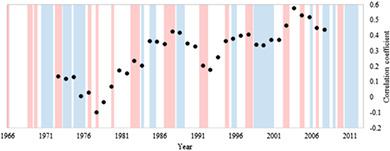当前位置:
X-MOL 学术
›
Meteorol. Appl.
›
论文详情
Our official English website, www.x-mol.net, welcomes your feedback! (Note: you will need to create a separate account there.)
Drought trend, frequency and extremity across a wide range of climates over Iran
Meteorological Applications ( IF 2.7 ) Pub Date : 2020-03-13 , DOI: 10.1002/met.1899 Milad Nouri 1, 2 , Mehdi Homaee 2
Meteorological Applications ( IF 2.7 ) Pub Date : 2020-03-13 , DOI: 10.1002/met.1899 Milad Nouri 1, 2 , Mehdi Homaee 2
Affiliation

|
This study was conducted to assess drought trend, frequency and extremity during 1966–2012 over widely different climatic regimes in Iran. Two drought indicators, i.e. the standardized precipitation index (SPI) and the standardized precipitation evapotranspiration index (SPEI), were employed to characterize the droughts at 3, 6, 12 and 24 month time scales. In addition, the Mann–Kendall test was used for trend analysis. There was a declining (drying) trend in the SPI and SPEI at 76% and 85% or more, respectively, of the investigated sites. The SPIs were not well correlated with the SPEIs over the hyper‐arid/arid regions, demonstrating the significance of reference evapotranspiration (ET0) inclusion for drought identification over these water‐limited areas. Furthermore, the SPEI appears not to be calculated reliably using temperature‐based ET0 equations and also when wind speed data are missing at hyper‐arid/arid sites. More frequent droughts were detected during 1998–2012, which can be attributed to more recurrent La Niña events in this period. Seasonally, a greater increment in drought frequency at 3 and 6 month time scales was found in the March–April–May period. The most extended droughts and the most intensive dry months were also captured over 1998–2012 for most locations. In the majority of cases, it seems that the 1998–2001, 2007–2009 and 2010–2012 La Niña events caused long and severe droughts. The drought frequency increment and the most extreme drought incidences seem to have adversely impacted the agricultural sector over the studied areas. Consequently, there is a need for adaptation to negate the influences of frequent intensive dry episodes in Iran.
中文翻译:

伊朗大范围气候中的干旱趋势,频率和极端
这项研究的目的是评估1966-2012年期间伊朗不同气候条件下的干旱趋势,频率和极端情况。两种干旱指标,即标准化降水指数(SPI)和标准化降水蒸散指数(SPEI),被用来表征3、6、12和24个月时间尺度的干旱。此外,Mann–Kendall检验用于趋势分析。SPI和SPEI分别有76%和85%或更高的下降(干燥)趋势。SPIs与超干旱/干旱地区的SPEI没有很好的相关性,证明了参考蒸散量的重要性(ET 0),以便在这些缺水地区识别干旱。此外,使用基于温度的ET 0似乎无法可靠地计算SPEI方程以及在超干旱/干旱地点缺少风速数据时。在1998年至2012年期间,发现了更频繁的干旱,这可以归因于此期间拉尼娜事件的频发。季节性地,在3月至4月至5月期间,在3个月和6个月的时间尺度上,干旱频率有较大的增加。1998-2012年期间,大多数地区还发生了最广泛的干旱和最密集的干旱月份。在大多数情况下,1998-2001年,2007-2009年和2010-2012年拉尼娜事件似乎造成了长期而严重的干旱。干旱频率增加和最极端的干旱发生率似乎对研究区域的农业部门产生了不利影响。因此,有必要进行调整,以消除伊朗频繁的密集干旱事件的影响。
更新日期:2020-03-13
中文翻译:

伊朗大范围气候中的干旱趋势,频率和极端
这项研究的目的是评估1966-2012年期间伊朗不同气候条件下的干旱趋势,频率和极端情况。两种干旱指标,即标准化降水指数(SPI)和标准化降水蒸散指数(SPEI),被用来表征3、6、12和24个月时间尺度的干旱。此外,Mann–Kendall检验用于趋势分析。SPI和SPEI分别有76%和85%或更高的下降(干燥)趋势。SPIs与超干旱/干旱地区的SPEI没有很好的相关性,证明了参考蒸散量的重要性(ET 0),以便在这些缺水地区识别干旱。此外,使用基于温度的ET 0似乎无法可靠地计算SPEI方程以及在超干旱/干旱地点缺少风速数据时。在1998年至2012年期间,发现了更频繁的干旱,这可以归因于此期间拉尼娜事件的频发。季节性地,在3月至4月至5月期间,在3个月和6个月的时间尺度上,干旱频率有较大的增加。1998-2012年期间,大多数地区还发生了最广泛的干旱和最密集的干旱月份。在大多数情况下,1998-2001年,2007-2009年和2010-2012年拉尼娜事件似乎造成了长期而严重的干旱。干旱频率增加和最极端的干旱发生率似乎对研究区域的农业部门产生了不利影响。因此,有必要进行调整,以消除伊朗频繁的密集干旱事件的影响。


























 京公网安备 11010802027423号
京公网安备 11010802027423号